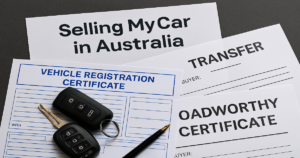Buying a used car can be a smart financial decision, but it also comes with risks—especially if you end up with a lemon. A lemon car refers to a vehicle with significant defects that impair its safety, value, or usability. Spotting a lemon before you buy is crucial to avoid costly repairs and regret down the road.
In this guide, we’ll share 12 essential tips to help you spot a lemon car and ensure you’re making a smart purchase.

1. Research the Car’s Reliability and Reputation
Before heading to inspect a used car, research its model’s reliability and common issues. Some cars have a history of frequent mechanical problems, so it’s essential to look at reliability reports and reviews. Use resources like JD Power, Consumer Reports, and your local automotive organizations (e.g., RACV, NRMA) for reliable insights. Also, check ANCAP Safety Ratings to assess the vehicle’s safety features.
2. Inspect the Exterior for Hidden Damage
A detailed walk-around of the car can reveal telltale signs of previous accidents or poor repairs. Look out for:
- Mismatched paint or body panels
- Dents, scratches, or rust spots
- Uneven gaps between body panels
- Paint overspray on windows, rubber seals, or wheel wells
To check for hidden bodywork repairs, use a small magnet on metal panels. If it doesn’t stick, the area may have body filler beneath the paint, indicating prior damage.
3. Examine the Interior for Wear and Tear
A car’s interior can provide valuable clues about its true mileage and how well it was maintained. Pay close attention to:
- Sagging headliners and cracked dashboards
- Worn-out seats, pedals, and steering wheel
- Malfunctioning electronics or missing buttons
- Seatbelts with frayed edges (a sign of previous impact)
If the interior shows excessive wear that doesn’t match the listed mileage, the odometer may have been tampered with.
4. Inspect the Engine Bay Thoroughly
The engine is the heart of any vehicle, so a detailed inspection is crucial. With the engine cool, check for:
- Oil leaks around the engine block
- Corrosion on battery terminals
- Worn-out belts and hoses
- Discoloration or burning smells (signs of overheating)
Ensure all fluid levels (oil, coolant, brake fluid) are topped up and clean.
5. Check the Tires and Wheels
Tire condition can tell you a lot about a car’s history. Inspect:
- Even tire wear across all four tires
- Sidewall damage or cracks
Uneven wear could indicate poor alignment, worn suspension parts, or even frame damage from a previous accident.
6. Test the Steering and Brakes
Turn the steering wheel while the car is idling and listen for clunking sounds or excessive play, which may indicate steering issues. During a test drive, pay attention to:
- Whether the car pulls to one side
- Shaking or vibrating steering wheels (indicating alignment issues or worn suspension)
- Unusual noises when braking (squealing or grinding could mean worn-out brake pads or rotors)
7. Inspect the Suspension
Push down firmly on each corner of the car and release. If the car rebounds more than twice, it may have worn shock absorbers. While driving over bumps, listen for knocking sounds, which could indicate suspension issues.
8. Watch for Smoke from the Exhaust
Different colors of smoke can indicate various engine problems:
- White smoke: Normal at startup but persistent white smoke can indicate a blown head gasket.
- Black smoke: An overly rich fuel mixture, which may require costly repairs to the air intake system.
- Blue smoke: Burning oil, which often signals internal engine wear.
9. Check for Transmission and Clutch Issues
For automatic transmissions, ensure smooth gear changes. A delayed response or jerking during shifts can indicate transmission problems.
For manual cars, test the clutch by driving in different gears and paying attention to slipping or grinding noises.
10. Listen for Engine Noises
When accelerating, listen for any knocking, pinging, or ticking sounds. These noises could point to serious internal engine issues, such as bad bearings or improper ignition timing.
11. Test the Electronics
Modern cars come with a variety of electronic features. Ensure that all of the following are functioning properly:
- Power windows and locks
- Air conditioning and heating
- Infotainment system
- Lights, indicators, and windshield wipers
Electrical issues can be expensive to fix, so don’t overlook this step.
12. Get a Professional Mechanic’s Inspection
No matter how confident you feel about your inspection, it’s always best to have a professional mechanic inspect the car before you finalize your purchase. A mechanic can lift the car to inspect the undercarriage for frame damage, fluid leaks, and other issues that may not be visible to the untrained eye.
Bonus Tips to Avoid a Lemon Car
- Check the PPSR Report: This report will show whether the car has been written off, stolen, or has any financial encumbrances.
- Look for Consistent Service Records: A well-maintained car will have a detailed service history showing regular maintenance.
- Avoid “Too Good to Be True” Deals: If a car is priced significantly lower than similar models, there’s likely a reason.
Final Thoughts: Don’t Let a Lemon Sour Your Car Buying Experience
Buying a used car doesn’t have to be stressful. By following these 12 essential tips, you can reduce the risk of buying a lemon and find a vehicle that offers great value for money. Remember, a thorough inspection, proper research, and professional advice are your best tools to avoid costly mistakes.
When you’re ready to start your search, visit AusCarsales.au, where you can find a wide range of reliable used cars with detailed listings to help you make an informed decision.



